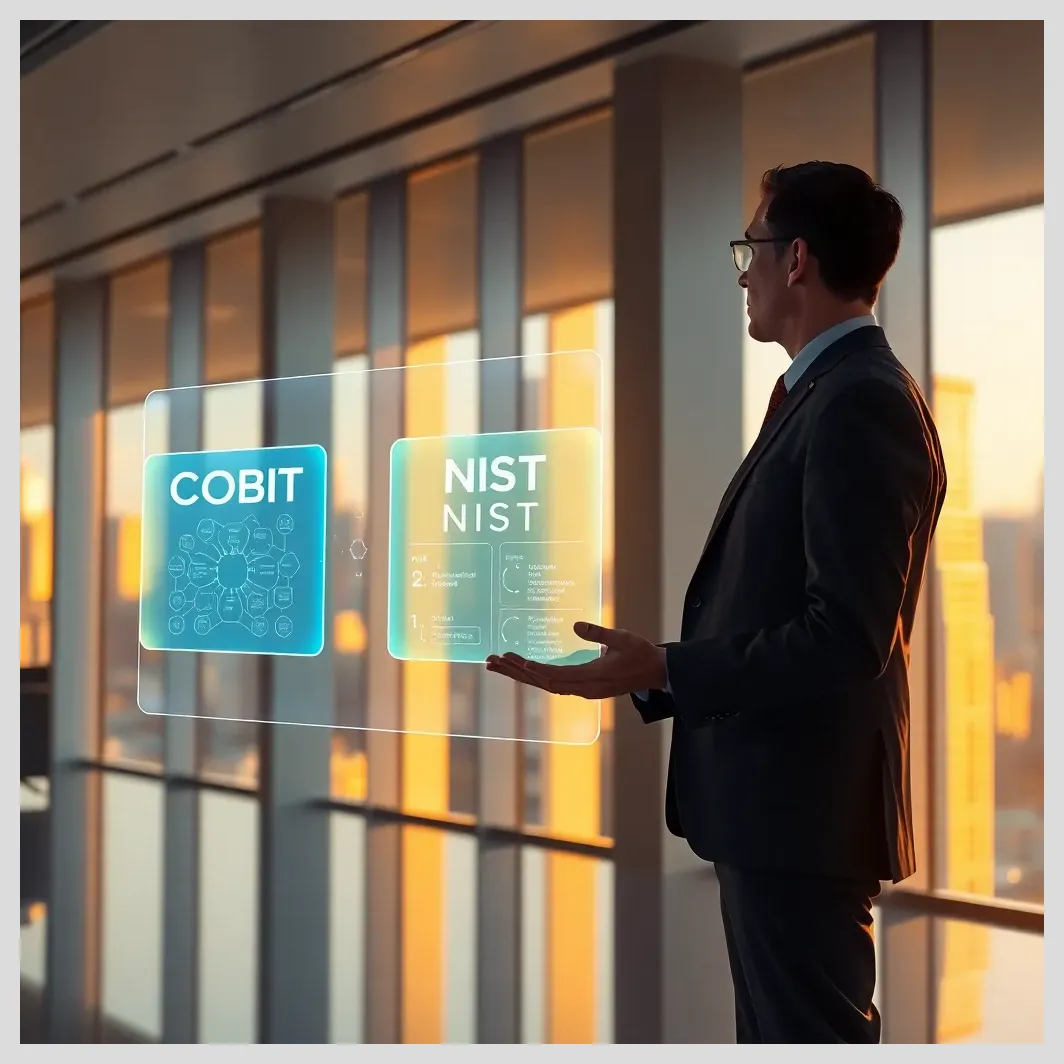In this article:
This article delves into the practical aspects of conducting a NIST CSF audit, explaining key concepts, processes, and tools necessary for effective implementation. It is designed to help organizations across the United States align their cybersecurity programs with federal standards, manage risks, and prepare for audits confidently.
Key points covered in this guide include
- Understanding the NIST Cybersecurity Framework and its role in IT audits
- Preparing for audits with essential terminology and concepts
- Step-by-step implementation from governance to continuous monitoring
- Utilizing practical tools and templates to streamline audit processes
- Integrating NIST CSF with broader compliance programs
- Overcoming common challenges and learning from real-world examples
- Comparing NIST CSF with other cybersecurity frameworks
- Future trends and maintaining audit readiness
Introduction to NIST CSF Audit: Practical Implementation Guide
IT audits are crucial for verifying that an organization’s information systems meet cybersecurity standards and regulatory requirements. They help identify vulnerabilities, assess risks, and ensure controls are effective. The NIST Cybersecurity Framework (CSF) has become a cornerstone for IT security and compliance, offering a structured approach to managing cybersecurity risks.
This guide focuses on the practical implementation of NIST CSF audits, providing detailed instructions and real-world examples. It aims to equip IT professionals, cybersecurity auditors, compliance officers, and risk managers with the knowledge and tools needed to conduct thorough audits aligned with federal standards.
By following this guide, organizations can enhance their security posture, streamline compliance efforts, and build resilience against cyber threats. Whether you are starting a new security program or improving an existing one, this guide offers a reliable roadmap for success.
The NIST Cybersecurity Framework (CSF) in IT Audits
The NIST CSF is a voluntary framework developed by the National Institute of Standards and Technology to help organizations manage and reduce cybersecurity risks. It is widely adopted across industries for its flexibility and alignment with federal regulations.
The framework is structured around five core functions
- Identify Understanding assets, risks, and organizational context.
- Protect Implementing safeguards to limit or contain cybersecurity events.
- Detect Developing activities to identify cybersecurity incidents promptly.
- Respond Taking action regarding detected cybersecurity events.
- Recover Restoring capabilities or services impaired by cybersecurity incidents.
NIST CSF aligns with other standards such as ISO 27001 and GDPR, making it a versatile tool for compliance and risk management. Its structured approach supports IT audits by providing clear categories and subcategories for evaluating controls and security posture.
Understanding the framework’s components is essential for auditors to assess how well an organization manages cybersecurity risks and complies with relevant regulations.

Preparing for a NIST CSF Audit: Key Concepts and Terminology
Before conducting a NIST CSF audit, it is important to grasp several foundational terms and concepts
- IT Audit A systematic evaluation of an organization’s information technology infrastructure, policies, and operations.
- Compliance Adherence to laws, regulations, and policies relevant to cybersecurity.
- Controls Safeguards or countermeasures implemented to mitigate risks.
- Risk Management The process of identifying, assessing, and mitigating risks.
- Gap Assessment Comparing current cybersecurity posture against desired standards or frameworks.
- Documentation Records and evidence supporting audit findings and compliance.
NIST publications such as 800-53 (security controls), 800-171 (protecting controlled unclassified information), and 800-30 (risk assessment guide) provide detailed guidance referenced in audits.
Audit readiness involves continuous monitoring and maintaining up-to-date documentation to demonstrate compliance at any time.
Common misconceptions include viewing NIST CSF as a checklist rather than a risk-based framework and underestimating the importance of continuous improvement.
Practical Tips for Implementing and Auditing the NIST Cybersecurity Framework (CSF)
Governance & Audit Preparation
- Define clear cybersecurity objectives and audit scope aligned with business priorities.
- Assign roles and responsibilities for audit and compliance teams with management oversight.
- Maintain up-to-date documentation and understand key audit terminology (e.g., controls, risk management, gap assessment).
Assessment & Risk Management
- Conduct a comprehensive asset inventory and classify critical systems by risk exposure.
- Perform risk assessments using simple methods like risk matrices to evaluate threats and impacts.
- Prioritize gaps based on risk appetite and business impact for effective remediation planning.
Control Implementation & Integration
- Deploy technical controls like firewalls, encryption, and intrusion detection systems.
- Integrate NIST CSF with other frameworks (ISO 27001, HIPAA) to ensure comprehensive compliance.
- Conduct employee training and awareness programs to strengthen security culture.
Monitoring & Continuous Improvement
- Establish KPIs and metrics to track cybersecurity performance and audit progress.
- Generate clear audit reports summarizing findings, control effectiveness, and compliance status.
- Adopt a continuous improvement mindset by regularly updating risk assessments and controls.
Tools & Automation
- Use pre-written templates for policies, procedures, and audit documentation to save time.
- Leverage automated tools like TRAC and Cymulate for control validation and real-time reporting.
- Automate vulnerability management and continuous monitoring to enhance audit efficiency.
Common Challenges & Best Practices
- Avoid unclear audit scope and ensure sufficient resources are allocated.
- Engage stakeholders early to build buy-in and smooth implementation.
- Regularly update policies and controls to reflect evolving threats and business needs.
Step-by-Step Implementation Process for NIST CSF Audit
Establishing Governance and Scope
Effective governance is the foundation of a successful NIST CSF audit. Start by defining your organization’s cybersecurity objectives and identifying critical assets that require protection.
Set the audit scope to align with business priorities and regulatory requirements. This ensures the audit focuses on relevant systems and processes.
Assign clear roles and responsibilities to audit and compliance teams, including management oversight and technical experts. This clarity supports accountability and efficient execution.
Document governance policies and procedures to guide the audit process and demonstrate organizational commitment to cybersecurity.
Developing a Current Cybersecurity Profile
Begin by conducting a comprehensive asset inventory, classifying hardware, software, data, and personnel according to their importance and risk exposure.
 COBIT 2025: IT Governance Audit Essentials
COBIT 2025: IT Governance Audit EssentialsMap existing controls to the NIST CSF categories and subcategories to understand your current cybersecurity posture. This mapping highlights strengths and areas needing improvement.
Document the current state with practical examples, such as implemented firewalls, access controls, and incident response plans.
This profile serves as a baseline for risk assessment and gap analysis.
Performing Risk Assessment and Gap Analysis
Identify threats and vulnerabilities relevant to your organizational context, considering internal and external factors.
Evaluate the likelihood and potential impact of risks using straightforward methods, such as risk matrices or scoring systems.
Conduct an enhanced gap assessment to pinpoint weaknesses in controls and processes compared to the target cybersecurity profile.
Prioritize gaps based on risk appetite, business impact, and available resources to focus remediation efforts effectively.
Defining Target Cybersecurity Profile and Controls
Set achievable cybersecurity goals aligned with your organization’s risk management strategy and compliance obligations.
Select and tailor controls to meet desired outcomes, considering the organization’s size, complexity, and industry.
Integrate NIST CSF with other frameworks like ISO 27001 or HIPAA to ensure comprehensive compliance and avoid duplication.
Document the target profile clearly to guide implementation and future audits.
Implementing Controls and Security Measures
Deploy technical controls such as firewalls, encryption, and intrusion detection systems alongside administrative measures like policies and training.
Employee awareness programs are critical to reinforce security culture and reduce human error.
Leverage automation tools for vulnerability management, continuous monitoring, and incident detection to enhance efficiency.
Maintain detailed records of control implementation to support audit evidence requirements.
Monitoring, Reporting, and Continuous Improvement
Establish metrics and key performance indicators (KPIs) to track progress toward cybersecurity goals.
Generate audit reports that summarize findings, control effectiveness, and compliance status for stakeholders.
Conduct periodic reviews to update risk assessments, address emerging threats, and refine controls.
Adopt a continuous improvement mindset to maintain resilience and adapt to evolving cybersecurity landscapes.
Practical Tools and Templates for NIST CSF Audit Implementation
Several toolkits and software solutions support NIST CSF audit processes by providing structured templates and automation capabilities.
 OWASP Audit Methodology: Secure Your Web Apps
OWASP Audit Methodology: Secure Your Web AppsPre-written templates for policies, procedures, and audit documentation reduce workload and ensure consistency.
Automated assessment tools and dashboards, such as TRAC and Cymulate, facilitate exposure discovery, control validation, and real-time reporting.
Using these tools streamlines audit workflows, improves accuracy, and accelerates compliance efforts.
Benefits and Risks
Benefits
Provides a structured, risk-based approach to cybersecurity management.
Enhances compliance with federal standards and regulatory requirements.
Flexible and adaptable to different industries and organizational sizes.
Supports continuous improvement and proactive risk management.
Availability of practical tools and templates streamlines audit processes.
Risks
Potential resource constraints and need for skilled personnel.
Complexity in integrating NIST CSF with legacy systems and other frameworks.
Risk of treating the framework as a checklist rather than a continuous process.
Resistance to change and lack of stakeholder engagement can hinder implementation.
Less prescriptive control guidance compared to other standards like ISO 27001.
Integrating NIST CSF Audit with Broader IT Audit and Compliance Programs
Aligning NIST CSF audits with internal audit procedures and IT governance frameworks enhances organizational oversight.
Coordinate with third-party assessments and formal certifications to leverage audit findings and reduce duplication.
Manage vendor and third-party risks within the NIST CSF framework to ensure supply chain security.
Ensure compliance across multiple standards by mapping controls and harmonizing audit activities.
Common Challenges and How to Overcome Them in NIST CSF Audits
Organizations often face pitfalls such as unclear scope, insufficient resources, and resistance to change.
Address resource constraints by prioritizing high-risk areas and leveraging automation.
Complex environments and legacy systems require tailored approaches and incremental improvements.
Effective communication and stakeholder engagement foster buy-in and smooth implementation.

Case Studies and Real-World Examples of NIST CSF Audit Implementation
Several organizations across industries have successfully adopted NIST CSF audits, improving their security posture and compliance.
Lessons learned include the importance of executive support, thorough documentation, and continuous training.
Audit findings often reveal gaps in incident response and vendor management, leading to targeted remediation.
These examples demonstrate tangible benefits such as reduced risk exposure and streamlined regulatory reporting.
Expert Opinions and Community Insights on NIST CSF Audits
Cybersecurity professionals emphasize the framework’s flexibility and risk-based approach as key strengths.
Trends include increased automation, integration with AI-driven analytics, and focus on ecosystem-wide risk management.
Authoritative sources provide ongoing guidance and updates to keep pace with evolving threats.
Comparison of Cybersecurity Frameworks for IT Audits
NIST CSF
Characteristics
Risk-based, flexible, five core functions
 Audit Frameworks: COBIT, NIST, ISO Compared
Audit Frameworks: COBIT, NIST, ISO ComparedUsability
Highly usable for federal compliance and risk management
Pros
Widely accepted, adaptable, integrates with other standards
Cons
Less prescriptive on controls than ISO 27001
Cost
Free (framework), toolkits vary
ISO 27001
Characteristics
International standard, management system focus
Usability
Formal certification available, structured audit process
Pros
Comprehensive, recognized globally
Cons
Certification costs, complex implementation
Cost
$5,000 – $50,000+ (certification)
COBIT
Characteristics
Governance and management framework for IT
Usability
Focus on IT processes and controls
Pros
Strong governance emphasis
Cons
Less focused on cybersecurity specifics
Cost
Varies by tool and training
CIS Controls
Characteristics
Prescriptive security controls, prioritized
Usability
Practical for technical control implementation
Pros
Easy to understand, actionable
Cons
Less comprehensive governance coverage
Cost
Free framework, paid tools available
Comparison of NIST CSF with Other Cybersecurity Frameworks for IT Audits
| Framework | Characteristics | Usability in Audits | Pros | Cons | Approximate Cost |
|---|---|---|---|---|---|
| NIST CSF | Risk-based, flexible, five core functions | Highly usable for federal compliance and risk management | Widely accepted, adaptable, integrates with other standards | Less prescriptive on controls than ISO 27001 | Free (framework), toolkits vary |
| ISO 27001 | International standard, management system focus | Formal certification available, structured audit process | Comprehensive, recognized globally | Certification costs, complex implementation | $5,000 – $50,000+ (certification) |
| COBIT | Governance and management framework for IT | Focus on IT processes and controls | Strong governance emphasis | Less focused on cybersecurity specifics | Varies by tool and training |
| CIS Controls | Prescriptive security controls, prioritized | Practical for technical control implementation | Easy to understand, actionable | Less comprehensive governance coverage | Free framework, paid tools available |
Checklist and Quick Reference for Conducting a NIST CSF Audit
- ✅ Define audit scope and governance structure
- ✅ Inventory assets and classify critical systems
- ✅ Map existing controls to NIST CSF categories
- ✅ Perform risk assessment and gap analysis
- ✅ Develop target cybersecurity profile and select controls
- ✅ Implement controls and conduct employee training
- ✅ Establish monitoring metrics and reporting mechanisms
- ✅ Maintain documentation and prepare audit evidence
- ✅ Schedule periodic reviews and continuous improvement
Best Practices, Tips, and Common Errors in NIST CSF Audit Implementation
Maintain clear documentation throughout the audit process to support findings and compliance.
Engage stakeholders early to ensure alignment and resource support.
Use automation tools to reduce manual workload and improve accuracy.
Avoid treating NIST CSF as a one-time checklist; embrace continuous risk management.
Common mistakes include unclear scope, insufficient training, and neglecting third-party risks.
Regularly update policies and controls to reflect changing threats and business needs.
Future Trends and Continuous Evolution of NIST CSF and IT Audits
NIST CSF 2.0 introduces enhanced guidance on supply chain risk management and privacy.
Emerging technologies like AI and machine learning are increasingly integrated into audit tools for predictive risk analysis.
Automation will continue to streamline compliance and monitoring activities.
Frameworks will evolve to address ecosystem-wide risks and support adaptive security strategies.
Building a Compliant and Resilient Security Program with NIST CSF Audits
Implementing a NIST CSF audit is a practical way to strengthen your organization’s cybersecurity posture and ensure compliance with federal standards.
By following the structured steps outlined in this guide, you can identify risks, deploy effective controls, and maintain continuous improvement.
Adopting a proactive mindset and leveraging available tools will help you build resilience against evolving cyber threats.
Ultimately, NIST CSF audits empower organizations to manage cybersecurity risks confidently and sustainably.
References and Further Reading
- Ultimate Guide to Implementing NIST CSF 2.0 – Oleh Dubetcky
- NIST CSF Implementation Guide – URM Consulting
- NIST Compliance Checklist – Cymulate
- NIST Cybersecurity Framework Guide and Toolkit – CertiKit
- TRAC: NIST Cybersecurity Framework Module
- HPH Sector Cybersecurity Framework Implementation Guide
- NIST CSF 2.0 Core with Implementation Examples – NIST
- NIST CSF Guide to Cybersecurity Framework
- What is a NIST Audit? – DataGuard
- Introduction To The NIST Cybersecurity Framework (CSF) – Wiz
Frequently Asked Questions
What is a NIST CSF audit and why is it important?
A NIST CSF audit evaluates how well an organization aligns its cybersecurity practices with the NIST Cybersecurity Framework. It is important because it helps identify risks, ensures compliance with federal standards, and strengthens overall security posture.
How do I start implementing a NIST CSF audit in my organization?
Begin by establishing governance and defining the audit scope. Conduct an asset inventory, map existing controls, perform risk assessments, and develop a target cybersecurity profile. Use practical tools and templates to guide the process.
What are the key differences between NIST CSF and ISO 27001?
NIST CSF is a flexible, risk-based framework focused on cybersecurity functions, while ISO 27001 is an international standard specifying requirements for an information security management system (ISMS) with formal certification options.
How often should NIST CSF audits be conducted?
Audits should be conducted regularly, at least annually, or more frequently depending on organizational risk, regulatory requirements, and changes in the IT environment.
What tools can help automate the NIST CSF audit process?
Tools like TRAC and Cymulate provide automated assessment, control validation, and reporting features that streamline NIST CSF audits and reduce manual effort.
We invite you to share your thoughts, questions, or experiences related to NIST CSF audits in the comments below. What do you think about implementing this framework in your organization? How do you handle challenges during audits? Would you like to see more examples or tools discussed? Your input helps us improve and tailor content to your needs!











